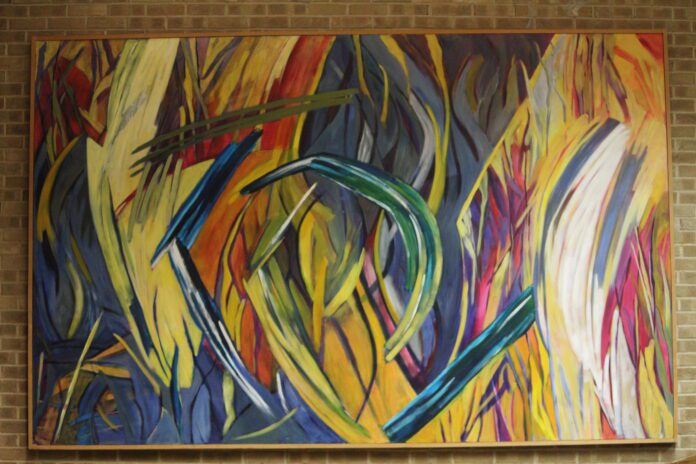A personal reflection
Disclaimer:
All articles published within this section of The Cor Chronicle are the opinions of the respective authors and do not necessarily reflect the opinions of The Cor Chronicle.
For twenty-five years I have been teaching in the brown brick, brown wood, overhead lighting and general airlessness of Gorman C. But more importantly, for twenty-five years–longer than any of my current students have been alive–I have been living with the modern art painting on the wall. No plaque indicates a title or artist for the work, although I have heard it rumored (there’s a UD tradition!) that it is an alumnus artist who has passed away.
After twenty-five years of 6 hours a day contact with the painting, I would like to share what the painting means to me.
First of all it could be entitled July 1-3, 1863. It first struck me as the bloody wheatfields of the battlefield of Gettysburg after Pickett’s charge. The burning golden heat of the day, the blood red stalks. A Red Badge of Courage? “Dulce et Decorem est Pro Patria Mori?”
Lincoln insisted that it was “dignum et iustem”–particularly this country, “conceived in liberty and dedicated to the proposition that all men are created equal.” Perhaps the painting is intentionally painful to look at, because it asks that starkly nihilistic question (one cannot find Ovid’s poem on Google because the internet is glutted with Wilfred Owen)? Perhaps it is beautiful because it never lets us forget the cost paid for Lincoln’s golden answer?
But no, anyone can see the implied Hammer and Sickle which forms the centerpiece of the painting. Surely we are too myopically American and patriotic to think that it is Gettysburg. It should be entitled The 1812 Overture after Tchaikovsky’s great anti-revolutionary orchestral bombast.
Ironically? The white snows of Russia do not seem to be defeating the revolutionary forces of Napoleon, nor even putting out the flames of burning Moscow. In fact, it is the ugliest, chalkiest white I have ever seen. Nothing luminescent about it–nothing to evoke the heart-rending beauty of the Russian children’s choirs and folk dances that hauntingly speak of a pre-revolutionary culture.
Apocalypse now? Now that we are pro- posing musical accompaniments, perhaps Johnny Cash’s “When the Man Comes to Town” is best.
After all, the ultimate burning wheat fields will be the separating of the wheat and the chaff. The wheat shall be gathered into sheaves. Gerard Manley Hopkins’s “barbarous in beauty” stooks. The chaff will be burned with fire. Because the Lord was wroth with his people. “Everyone won’t be treated all the same.”
I have no doubt, after twenty-five years, that it is apocalyptic. I propose, in honor to the work’s powerful presence through generations of Gorman C students, that it needs a title and an artist on a plaque. At the very least we could have the decency to admit that it is “Untitled,” by Anonymous.
